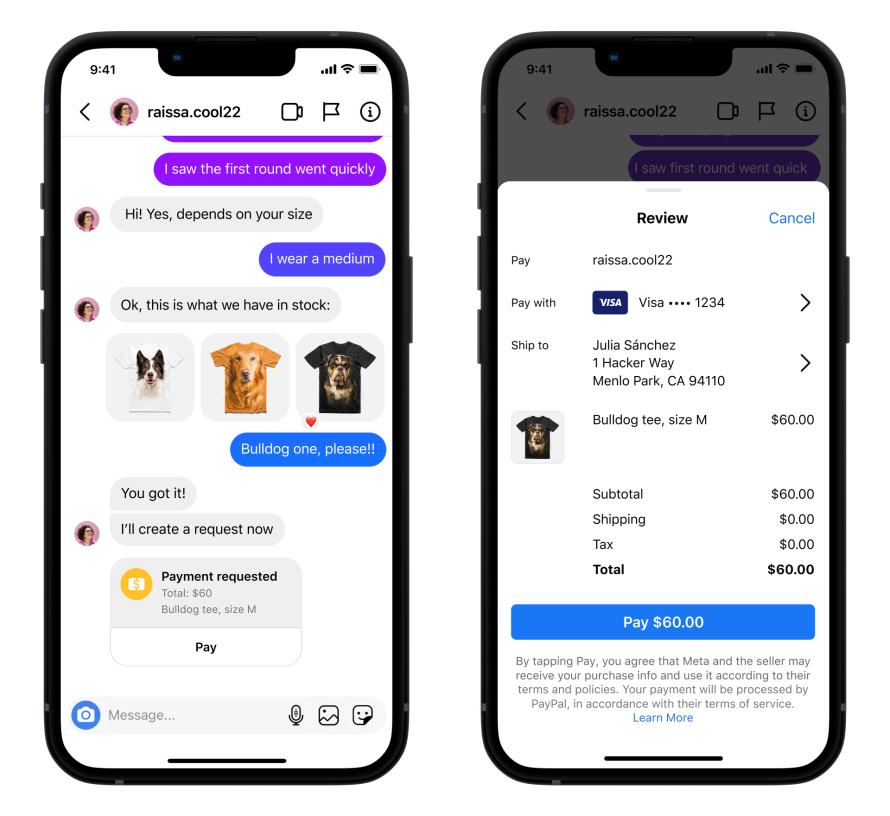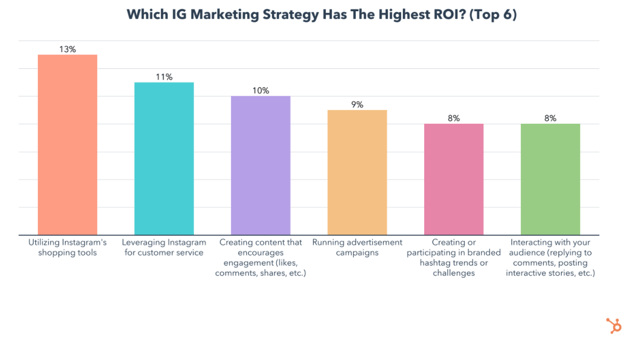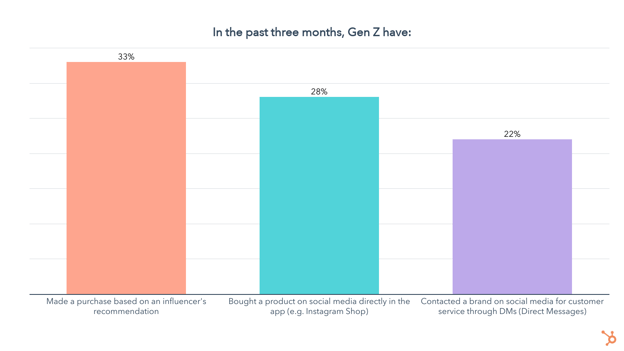Remember when social media was all about keeping up with your friends and family?
For better or worse, those days are gone as more social platforms are now focused on keeping you connected with an endless stream of products you can buy without even leaving the app.
In other words, social media is the next frontier of e-commerce, and DMs are the future of customer service.
That’s the bold claim we made after running our survey of 500+ Instagram marketers earlier this year -- but Instagram recently announced a big change confirming our theory.
In July, Instagram revealed that the app will let shoppers place and track orders directly in their DMs.
What Instagram's DM Shopping Feature Looks Like
Instagram's new DM features are similar to the messaging features of WhatsApp payments. Rather than going to a brand's online retail store or Facebook/Instagram Shop, prospective customers can now shop and search for products with help from brand representatives on messenger.
Meta's announcement notes that businesses that enable the feature can:
- Chat with customers in real-time to answer questions and confirm purchase details.
- Create a payment request with item description and price.
- Request and collect payment.
Below is a preview of what this messaging feature looks like:

Why This Could be Big for Businesses
Why is this a big deal? For starters, our Instagram Marketing Trends Report shows that using the app’s shopping tools and leveraging DMs for customer service are the highest ROI strategies on the platform.

But while these tools may be working for marketers, are people actually buying products on Instagram and turning to DMs for customer service?
The results of another recent consumer trends survey we ran might surprise you:
- 28% of social media users age 18-34 have bought a product directly in a social media app in the past three months
- 1 in 4 people age 18-24 have used social media DMs for customer service in the past three months
- 33% of social media users age 18-24 have bought a product based on an influencer’s recommendation in the past three months
- Social media is Gen Z’s preferred channel for discovering new products. 57% of Gen Z have discovered a new product on social media in the past three months
- Social media is also Millennials preferred channel for discovering new products. 1 in 2 Millennials have discovered a new product on social media in the past three months

While this data isn’t specific to Instagram, the app is currently at the forefront of the shift into e-commerce happening across social media platforms. YouTube just announced integrations with Shopify and Twitter is testing new shopping features, but Instagram seems to be slightly ahead of the curve.
That’s why Instagram is currently the best social media platform for selling products online. We even published a guide to Instagram’s various social media shopping tools and which perform best, based on our survey of 580+ Instagram marketers.
What’s Next for Social Shopping?
Social shopping isn’t necessarily new, but it’s being implemented and adopted in real-time by both consumers and marketers. Looking forward, we can confidently say that you’ll see Instagram continue embracing the shopping experience, and other social channels will likely follow suit.
When it comes to how marketers and consumers will interact with these shopping tools, it’s too early to tell. While social shopping shows huge potential based on our data, users might flee social media platforms as they become less about connecting us with the people we know and more about selling products.
Regardless, Gen Z and Millennials spend around four hours a day on social media, and social media is their preferred way of discovering new products, so there’s no better way to reach them.
As social selling evolves, we’ll be running our consumer trends survey bi-annually to keep track of how quickly social media users embrace these changes and keep surveying social media marketers to see if using these social shopping tools remains a top strategy.
from Marketing https://blog.hubspot.com/marketing/instagram-dm-shopping
Remember when social media was all about keeping up with your friends and family?
For better or worse, those days are gone as more social platforms are now focused on keeping you connected with an endless stream of products you can buy without even leaving the app.
In other words, social media is the next frontier of e-commerce, and DMs are the future of customer service.
That’s the bold claim we made after running our survey of 500+ Instagram marketers earlier this year -- but Instagram recently announced a big change confirming our theory.
In July, Instagram revealed that the app will let shoppers place and track orders directly in their DMs.
What Instagram's DM Shopping Feature Looks Like
Instagram's new DM features are similar to the messaging features of WhatsApp payments. Rather than going to a brand's online retail store or Facebook/Instagram Shop, prospective customers can now shop and search for products with help from brand representatives on messenger.
Meta's announcement notes that businesses that enable the feature can:
- Chat with customers in real-time to answer questions and confirm purchase details.
- Create a payment request with item description and price.
- Request and collect payment.
Below is a preview of what this messaging feature looks like:

Why This Could be Big for Businesses
Why is this a big deal? For starters, our Instagram Marketing Trends Report shows that using the app’s shopping tools and leveraging DMs for customer service are the highest ROI strategies on the platform.

But while these tools may be working for marketers, are people actually buying products on Instagram and turning to DMs for customer service?
The results of another recent consumer trends survey we ran might surprise you:
- 28% of social media users age 18-34 have bought a product directly in a social media app in the past three months
- 1 in 4 people age 18-24 have used social media DMs for customer service in the past three months
- 33% of social media users age 18-24 have bought a product based on an influencer’s recommendation in the past three months
- Social media is Gen Z’s preferred channel for discovering new products. 57% of Gen Z have discovered a new product on social media in the past three months
- Social media is also Millennials preferred channel for discovering new products. 1 in 2 Millennials have discovered a new product on social media in the past three months

While this data isn’t specific to Instagram, the app is currently at the forefront of the shift into e-commerce happening across social media platforms. YouTube just announced integrations with Shopify and Twitter is testing new shopping features, but Instagram seems to be slightly ahead of the curve.
That’s why Instagram is currently the best social media platform for selling products online. We even published a guide to Instagram’s various social media shopping tools and which perform best, based on our survey of 580+ Instagram marketers.
What’s Next for Social Shopping?
Social shopping isn’t necessarily new, but it’s being implemented and adopted in real-time by both consumers and marketers. Looking forward, we can confidently say that you’ll see Instagram continue embracing the shopping experience, and other social channels will likely follow suit.
When it comes to how marketers and consumers will interact with these shopping tools, it’s too early to tell. While social shopping shows huge potential based on our data, users might flee social media platforms as they become less about connecting us with the people we know and more about selling products.
Regardless, Gen Z and Millennials spend around four hours a day on social media, and social media is their preferred way of discovering new products, so there’s no better way to reach them.
As social selling evolves, we’ll be running our consumer trends survey bi-annually to keep track of how quickly social media users embrace these changes and keep surveying social media marketers to see if using these social shopping tools remains a top strategy.


No hay comentarios:
Publicar un comentario